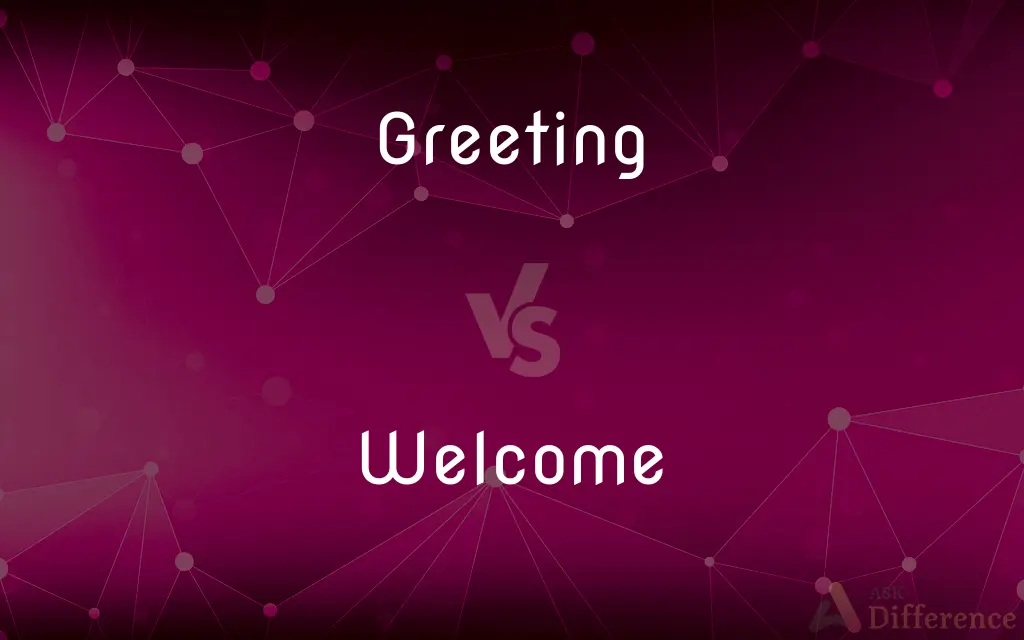Greeting vs. Welcome — What's the Difference?
Edited by Tayyaba Rehman — By Maham Liaqat — Updated on March 7, 2024
A greeting is a polite word or sign of welcome or recognition, used universally in various forms, while a welcome specifically signifies a warm reception or acceptance upon arrival.

Difference Between Greeting and Welcome
Table of Contents
ADVERTISEMENT
Key Differences
A greeting encompasses a wide range of expressions, from a simple "hello" or handshake to more formal salutations, used to acknowledge someone's presence or introduce a conversation. On the other hand, a welcome is more focused on the act of receiving someone warmly into a new place or situation, often conveyed through phrases like "welcome home" or "welcome to the team," indicating a positive acceptance into a specific environment or group.
Greetings can be exchanged between individuals who meet for the first time or as a common courtesy among acquaintances, signaling the start of an interaction. Whereas, welcoming someone usually follows the greeting and is a gesture of hospitality, showing that the person is received with open arms and positivity in a particular space or community.
While greetings can be casual or formal, depending on the context and relationship between the people involved, welcomes are inherently positive and aimed at making someone feel comfortable and valued in a new or familiar setting. This distinction highlights the different purposes these expressions serve in social interactions.
In cultural contexts, greetings are essential daily communications that vary widely across societies, reflecting customs, traditions, and social norms. On the other hand, welcomes are often associated with special occasions or the introduction to a new environment, emphasizing the importance of making someone feel accepted and included.
Despite their differences, both greetings and welcomes are fundamental to human social interactions, fostering goodwill, and building relationships. They play crucial roles in communication, helping to navigate the complexities of human connections and communal living.
ADVERTISEMENT
Comparison Chart
Definition
A polite word or sign of recognition or introduction.
A warm reception or acceptance upon arrival.
Purpose
To acknowledge someone's presence or to start a conversation.
To make someone feel accepted and comfortable in a new place or situation.
Form
Can be casual or formal, depending on the context.
Generally warm and positive, emphasizing hospitality.
Occasion
Used universally in daily interactions or meetings.
Often associated with someone’s arrival to a new place or situation.
Cultural Significance
Reflects customs, traditions, and norms in daily communication.
Emphasizes the importance of hospitality and inclusion in special occasions or environments.
Compare with Definitions
Greeting
Signals the beginning of an interaction or conversation.
The meeting started with greetings exchanged among participants.
Welcome
Implies hospitality and a readiness to make someone feel comfortable.
The hotel staff's welcome made their stay memorable.
Greeting
Reflects social etiquette and norms.
Sending a greeting card is customary for her during the holidays.
Welcome
A warm reception given to someone on their arrival.
The community gave the new residents a hearty welcome.
Greeting
Varies widely across different cultures and contexts.
In Japan, a bow is a common greeting.
Welcome
Often used to express happiness at someone's arrival.
You're here! Welcome!
Greeting
An expression of recognition or salutation upon meeting someone.
He offered a friendly greeting as they met.
Welcome
Can be a gesture of acceptance into a group or environment.
He was welcomed into the team with open arms.
Greeting
Can be verbal or non-verbal, like a handshake or nod.
A nod served as a greeting between the two strangers.
Welcome
Associated with special occasions or entering new places.
A welcome ceremony is planned for the new university students.
Greeting
Greeting is an act of communication in which human beings intentionally make their presence known to each other, to show attention to, and to suggest a type of relationship (usually cordial) or social status (formal or informal) between individuals or groups of people coming in contact with each other. Greetings are sometimes used just prior to a conversation or to greet in passing, such as on a sidewalk or trail.
Welcome
A welcome is a kind of greeting designed to introduce a person to a new place or situation, and to make them feel at ease. The term can similarly be used to describe the feeling of being accepted on the part of the new person.
Greeting
A word or gesture of welcome or salutation.
Welcome
An instance or manner of greeting someone
You will receive a warm welcome
He went to meet them with his hand stretched out in welcome
Greeting
A conventional phrase used to start a letter or conversation or otherwise to acknowledge a person's arrival or presence.
It's polite to begin a letter with a greeting, but this practice is less common in email.
Welcome
Used to greet someone in a polite or friendly way
Welcome to the Wildlife Park
Greeting
(uncountable) The action of the verb to greet.
Welcome
Greet (someone arriving) in a polite or friendly way
Hotels should welcome guests in their own language
Greeting
Present participle of greet
Welcome
(of a guest or new arrival) gladly received
I'm pleased to see you, lad—you're welcome
Greeting
Expression of kindness or joy; salutation at meeting; a compliment from one absent.
Write to him . . . gentle adieus and greetings.
Welcome
Very pleasing because much needed or desired
The news will be most welcome to those whose jobs will now be safeguarded
After your walk, the tea room serves a welcome cuppa
Greeting
(usually plural) an acknowledgment or expression of good will (especially on meeting)
Welcome
Allowed or invited to do a specified thing
We arrange a framework of activities which you are welcome to join
Welcome
Received with pleasure and hospitality into one's company or home
A welcome guest.
Welcome
Giving pleasure or satisfaction; agreeable or gratifying
A welcome respite from hard work.
Welcome
Cordially or willingly permitted or invited
You are welcome to join us.
Welcome
Used in the expression you're welcome to acknowledge an expression of gratitude.
Welcome
A cordial greeting or hospitable reception given to an arriving person.
Welcome
A reception upon arrival
Gave the stranger an unfriendly welcome.
Welcome
The state of being welcome
Don't overstay your welcome.
Welcome
To greet, receive, or entertain (another or others) cordially or hospitably.
Welcome
To receive or accept gladly
Would welcome a little privacy.
Welcome
Used to greet cordially a visitor or recent arrival.
Welcome
Whose arrival is a cause of joy; received with gladness; admitted willingly to the house, entertainment, or company.
A welcome visitor
Refugees welcome to education!
Welcome
Producing gladness.
A welcome present;
Welcome news
Welcome
Free to have or enjoy gratuitously.
You are welcome to the use of my library.
Welcome
Greeting given upon someone's arrival.
Welcome
The act of greeting someone’s arrival, especially by saying "Welcome!"; reception.
Welcome
The utterance of such a greeting.
Welcome
Kind reception of a guest or newcomer.
We entered the house and found a ready welcome.
Welcome
The state of being a welcome guest.
Welcome
To affirm or greet the arrival of someone, especially by saying "Welcome!".
Welcome
To accept something willingly or gladly.
We welcome suggestions for improvement.
Welcome
Received with gladness; admitted willingly to the house, entertainment, or company; as, a welcome visitor.
When the glad soul is made Heaven's welcome guest.
Welcome
Producing gladness; grateful; as, a welcome present; welcome news.
Welcome
Free to have or enjoy gratuitously; as, you are welcome to the use of my library.
Welcome
Salutation to a newcomer.
Welcome
Kind reception of a guest or newcomer; as, we entered the house and found a ready welcome.
His warmest welcome at an inn.
Truth finds an entrance and a welcome too.
To thee and thy company I bidA hearty welcome.
Welcome
To salute with kindness, as a newcomer; to receive and entertain hospitably and cheerfully; as, to welcome a visitor; to welcome a new idea.
Thus we salute thee with our early song,And welcome thee, and wish thee long.
Welcome
The state of being welcome;
Don't outstay your welcome
Welcome
A greeting or reception;
The proposal got a warm welcome
Welcome
Accept gladly;
I welcome your proposals
Welcome
Bid welcome to; greet upon arrival
Welcome
Receive someone, as into one's house
Welcome
Giving pleasure or satisfaction or received with pleasure or freely granted;
A welcome relief
A welcome guest
Made the children feel welcome
You are welcome to join us
Common Curiosities
What distinguishes a greeting from a welcome?
A greeting is an acknowledgment or salutation, while a welcome is a warm reception or acceptance.
How do cultural norms affect greetings and welcomes?
Cultural norms heavily influence the form and manner of greetings and welcomes, reflecting societal values and traditions.
Are greetings always verbal?
No, greetings can be non-verbal, such as a handshake, bow, or smile.
Is a welcome only used upon first meeting someone?
No, welcomes can be used anytime someone is received warmly, not just upon first meeting.
Can the same words be used for greeting and welcoming someone?
Yes, certain phrases like "hello" or "welcome" can serve both as greetings and welcomes depending on the context.
Why are greetings important in social interactions?
Greetings are crucial for initiating communication, showing respect, and acknowledging the other person's presence.
What are some common forms of greetings around the world?
Common forms include handshakes, bows, hugs, kisses on the cheek, and verbal greetings specific to each language.
How do online platforms convey greetings and welcomes?
Online platforms use welcome messages, emails, and onboarding screens to greet and welcome users or customers.
Is it possible to give a welcome without a greeting?
Typically, a greeting precedes a welcome as part of the process of receiving someone warmly.
Can a welcome be considered a greeting?
Yes, a welcome can be part of a greeting, but it specifically signifies a warm reception to a new place or situation.
Can welcomes be customized in a hospitality context?
Yes, welcomes can be personalized in hospitality to match guest preferences, making their reception more memorable and special.
What role do greetings play in professional settings?
In professional settings, greetings help establish a respectful and cordial atmosphere, facilitating better communication and collaboration.
What is the significance of a welcome home?
A "welcome home" signifies a warm and loving reception for someone returning after an absence, emphasizing belonging and comfort.
How does a welcome enhance someone’s experience in a new environment?
A warm welcome makes someone feel valued and comfortable, enhancing their experience in a new place or group.
How can businesses show a welcome to new customers?
Businesses can show a welcome through friendly greetings, signages like "Welcome to our store," and initial customer service interactions.
Share Your Discovery

Previous Comparison
Impulsive vs. Spontaneous
Next Comparison
Pin vs. PitAuthor Spotlight
Written by
Maham LiaqatEdited by
Tayyaba RehmanTayyaba Rehman is a distinguished writer, currently serving as a primary contributor to askdifference.com. As a researcher in semantics and etymology, Tayyaba's passion for the complexity of languages and their distinctions has found a perfect home on the platform. Tayyaba delves into the intricacies of language, distinguishing between commonly confused words and phrases, thereby providing clarity for readers worldwide.














































